Key Takeaways
Rising labor costs, globalization and high competition are driving companies to outsource.
By outsourcing routine tasks to virtual assistants, businesses can save up to 21 days a year.
If there’s a lack of specialized local talent, outsourcing lets you hire global candidates for web design, marketing, e-commerce support and more.
For a smooth start, draft clear project guidelines and SOPs before onboarding virtual assistants.
Labor costs are on the rise in the United States, but agile businesses have found a way around them.
Their solution? Outsourcing virtual assistants!
By tapping into the global talent pool, companies can find educated, tech-savvy workers and finally scale affordably.
In this article, we talk about the meaning, benefits and how-tos of virtual assistant outsourcing.
You will also learn how a virtual assistant’s support can boost productivity and take your business to new heights!
What Is Virtual Assistant Outsourcing?
Virtual assistants (VA) are often outsourced for the administrative tasks of an organization.
They handle all digital back-office work for global businesses from a remote location. You can choose from many types of VAs as per your requirements.
Depending on their location, there are three main types of VA outsourcing:
- Onshore: Outsourcing locally within the same country (E.g., USA)
- Nearshore: Outsourcing to an agency in a neighboring country within the same time zone (E.g., Canada, Mexico, etc.)
- Offshore: Outsourcing from a foreign country in a different time zone (E.g., India, Philippines, etc.)
While it depends on the company’s unique needs, offshore outsourcing has been hailed as the most cost-efficient.
Some of the most commonly outsourced services are finance, HR and IT. Companies also outsource admin virtual assistants for email management, CRM handling, data entry, scheduling and more.
Specialized talents offer services like customer service, marketing and bookkeeping.
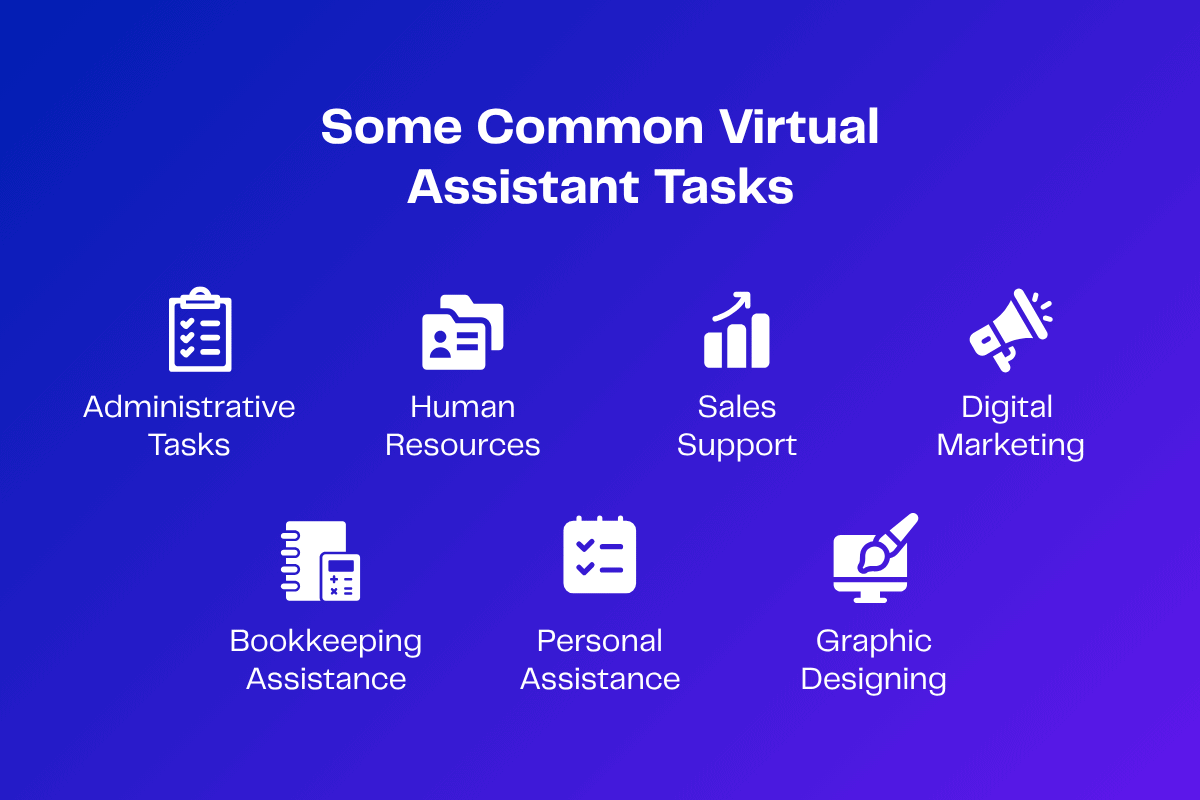
General Admin Support
There are many routine tasks businesses can outsource to virtual assistants.
These include:
- Responding to emails
- Handling data entry
- Managing the CRM database
- Filing employee documents
- Maintaining a centralized calendar
- Managing executive schedules
- Sending reminders for meetings
- Preparing invoices
- Booking travel plans
Specialized Services
Specialized services offered by virtual assistants are:
- Graphic design
- Social media management
- Web development
- Bookkeeping
- Executive assistance
- Personal assistance
- Customer support
- Digital Marketing
- Paralegal services
Benefits of Virtual Assistant Outsourcing
In this digital age, virtual assistants are increasingly replacing in-office assistants. They help companies cut costs, streamline operations, standardize processes and turbocharge productivity!
Let’s look at how they compare to in-office employees.
| Factor | In-House Employee | Virtual Assistant |
|---|---|---|
| Cost | Expensive | Highly affordable |
| Employee Benefits | Health insurance, holidays, paid leaves | No employee benefits |
| Overhead Expenses | Office space, utilities, equipment, tea/coffee | No overhead expenses |
| Talent Pool | Limited to local talent | Access to global talent |
| Recruitment | Long process with multiple rounds | Quick hiring and replacement |
| Working Hours | Fixed | Flexible |
| Training Requirements | Lengthy training period | Minimal training |
| Contract Flexibility | Rigid, long-term commitments | Flexible, short-term arrangements |
Hiring a virtual assistant is a great business strategy. Here are the top benefits you can gain from your next offshore hire!
Low Costs
From office space and tech equipment to employee salaries, the operating costs of running a business are higher than ever.
Full-time employees also require benefits, which further increase your expenses. Benefits alone account for almost 30% of total employment costs.
These include paid leaves, overtime pay, health insurance and retirement funds.

When you hire virtual assistants, there’s no need to pay for such benefits. Plus, virtual assistant rates are practically one-third of the salary of full-time employees. This is the main reason why businesses prefer to outsource.
Hiring a VA can cut down on costs for:
- Recruitment
- Overhead
- Office space and utilities
- Employee benefits
- Statutory and regulatory taxes
You can also delegate your core team’s repetitive tasks. Team members will be free to work on essential projects within business hours, cutting down your overtime costs!
Time Management
When your team is juggling essential and routine tasks, it slows down business and degrades work quality.
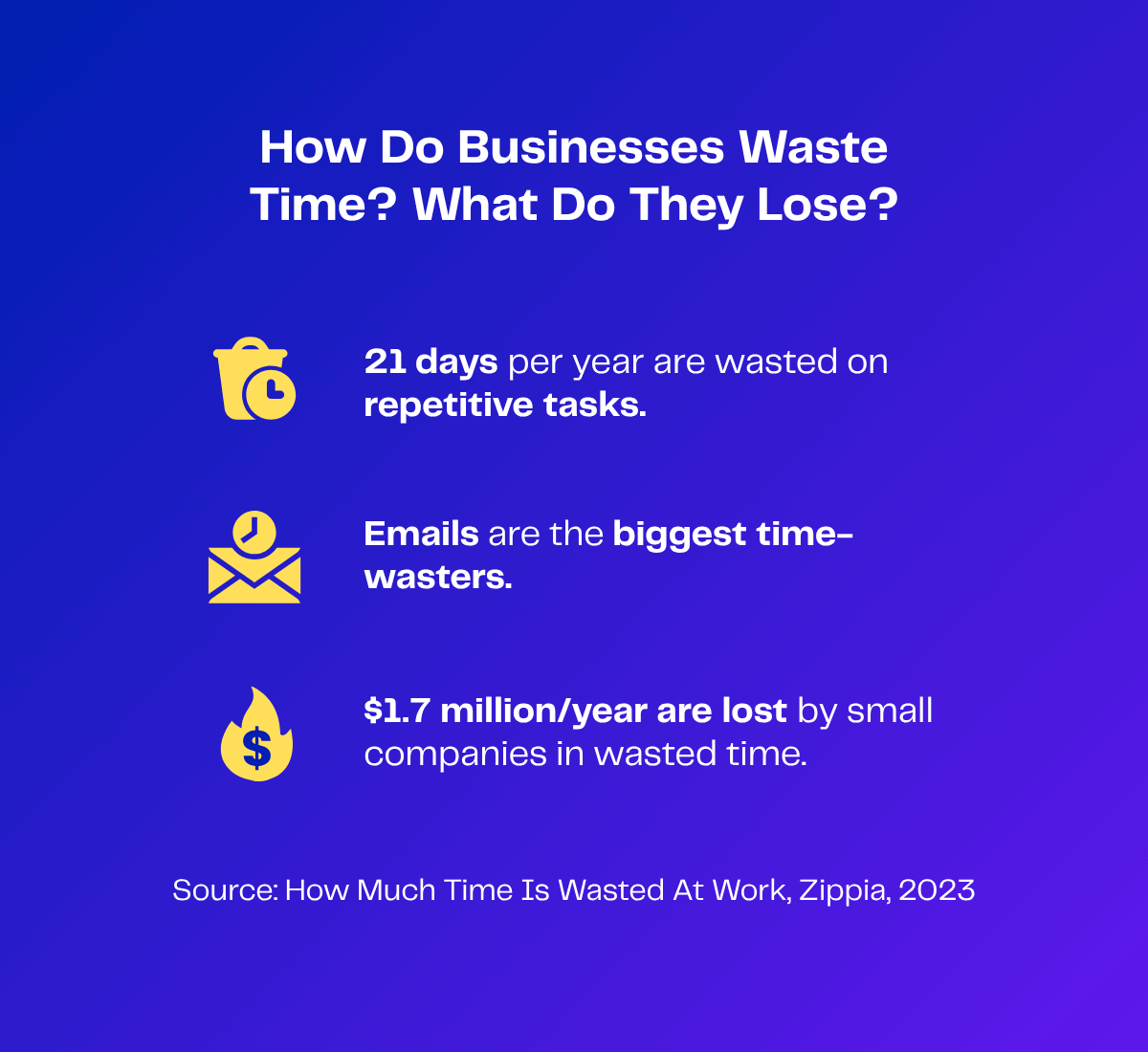
In fact, around 21 days per year are wasted on repetitive work. So as it turns out, not having back-office support does bite your business in a major way, even leading to financial losses.
By hiring a virtual assistant, you can earn back this valuable time. They can easily handle repetitive tasks such as responding to emails, scheduling appointments and preparing invoices.
You get to focus on invigorating business tasks—free from admin work!
Streamlined Operations
Streamlined processes reduce errors and speed up your projects.
A virtual assistant can analyze your existing processes and identify loopholes or bottlenecks. You can also ask them to automate these processes and set up newer software for specific tasks.
They’re also good at documenting your current processes. Creating SOPs helps clarify job responsibilities and organize knowledge assets. This way, you won’t have to explain everything to every new employee in the future.
Work-Life Balance
Overworking leads to exhaustion, stress or worse, burnout. It degrades your overall well-being.
If you spread yourself too thin at work, both your personal and professional lives will suffer. You’ll never have time for family or friends and might as well say goodbye to rest and recharge.
But a virtual assistant can help you and your core team set a healthy work-life balance.
They can manage your schedule, handle draining tasks, run personal errands and even fill in for you whenever suitable.
The best part is that since these VAs are trained, you won’t have to micromanage them!
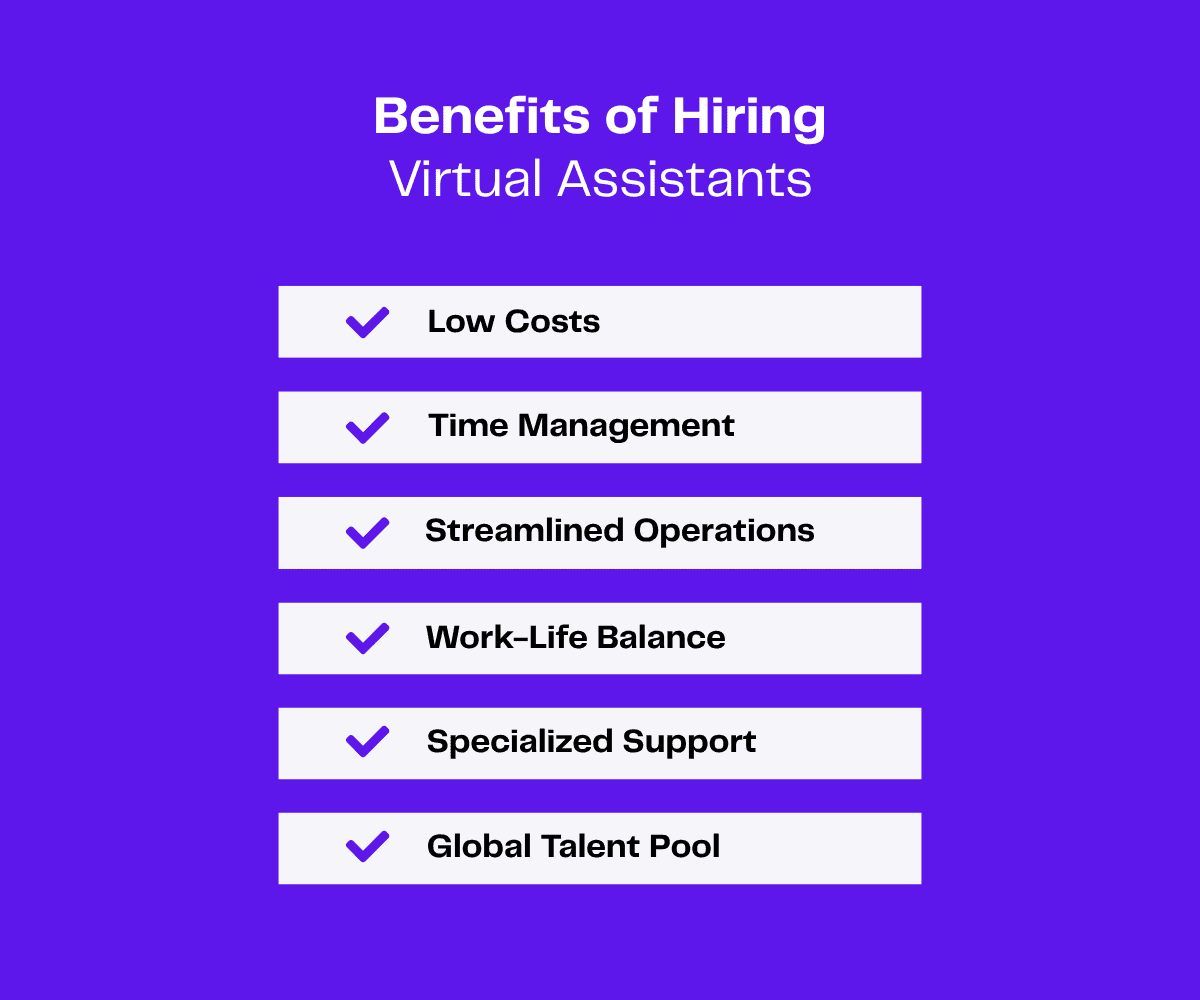
Specialized Services
Skills gaps due to fast-moving market trends are a typical problem in teams. The company’s quality of service can degrade if they don’t have expert professionals performing skilled tasks.
Specialized virtual assistants can be onboarded as per your needs to fill these gaps. By quickly hiring one, two or even a team of VAs, you can diversify your team, improve project quality and expand your service horizon.
Their services can include web design, social media management, email marketing, e-commerce support and real estate assistance.
With a skilled VA on your side, you don’t have to cut corners.
Global Talent Pool
With remote work gaining popularity, employee location has increasingly become irrelevant. Companies are finally prioritizing skills and competence over their new hire’s location.
The global talent pool is rich with professional college graduates. By outsourcing virtual assistants from a reliable agency like Zenius, you can hire the perfect match and scale seamlessly.
Signs It’s Time To Outsource
From startups to small businesses, any business can benefit from a virtual assistant’s support.
But often, executives and entrepreneurs fall into the trap of multitasking. They’re engaged in multiple tasks without giving meaningful attention to important work.
They keep on working on the wrong tasks—oblivious to the obvious.
For the few who do accept that they need more support, high labor costs remain a challenge.
Here are some more problems you might be facing:
- You’re stuck doing tasks that can be easily done by someone else.
- Your core team is constantly asking to push deadlines.
- Clients are complaining about poor quality work.
- You don’t have enough people to handle new clients.
- You want a specific skill set, but in-house hiring is expensive.
- You’re working in the business instead of on it.
- There’s no time for knowledge work and profit-making activities.
- Your family complains about not seeing you enough.
- You have not taken a vacation in months.
- You miss out on social events.
- You constantly feel exhausted and are running on fumes.
If you find yourself in such a situation, it’s time to stop, reassess and get in touch with a reliable outsourcing agency.
The Virtual Assistant Hiring Process
Define Expectations
Before you go about hiring a virtual assistant, you must know what area of your business needs support and how much of it is needed.
To do this, start by listing all your daily tasks. From this list, separate tasks that only you can do from tasks that can be done by someone else. The latter contains tasks that can be delegated to a virtual assistant.
Prepare a thorough job description. This document will simplify the hiring process. Write all job duties, responsibilities, required skill sets, qualifications and relevant workflow details.
It should also include details on expected deadlines, preferred modes of communication, software proficiency requirements and more.
The job description can be used post-onboarding as a measure of performance.
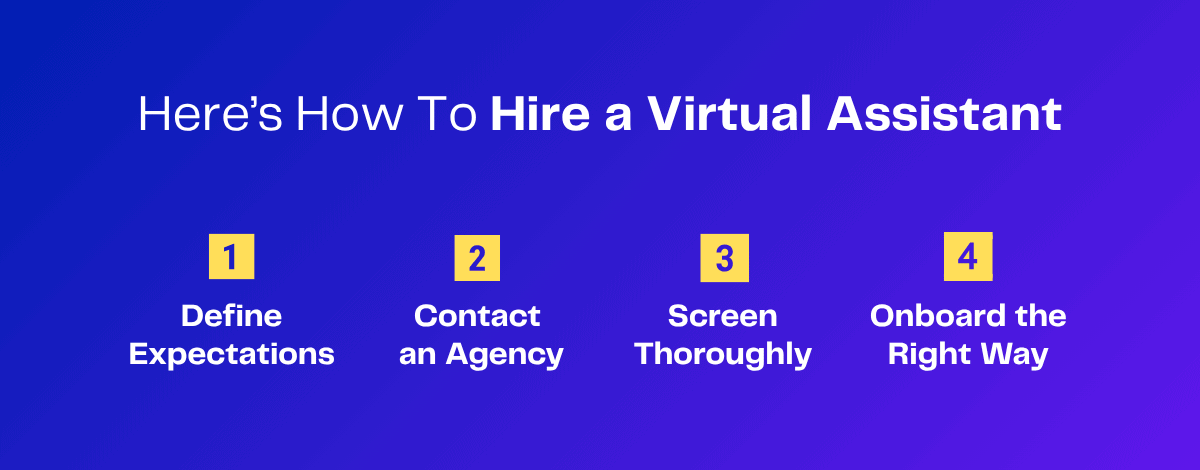
Contact the Best Outsourcing Agency
Once you clearly understand your needs, you can start looking up outsourcing agencies.
Because of the low operating costs, third-world agencies provide highly educated talents at competitive rates.
Zenius is a leading agency, offering the top 1% of global candidates!
Hop on a quick discovery call and share your requirements. Once a dedicated account manager is assigned to you, they will send over a set of recommendations. You can review candidates’ resumes and choose your favorites for the qualifying assessment.
Screen Thoroughly
Our experts review the assessments and shortlist the top performers.
At Zenius, our screening process prioritizes personality matches just as much as technical proficiency. So we welcome you to partake in the interviews if you’d like.
Just remember to ask the right questions to elicit insightful answers. Make ample notes and create a numbered scorecard for each candidate.
You can now choose the candidate that best fits your job description. Be mindful of any hiring biases and make an impartial decision purely based on capability and personality.
Inform the agency and sign the agreement to finalize things. Remember that we offer scalable support, so the agreement terms are flexible for you! You can always:
- Increase your VA’s hours
- Hire another VA
- Onboard a dedicated team of VAs
Before work starts, be proactive and learn about the best ways to delegate tasks effectively.
Onboard the Right Way
Onboarding is the most important step in establishing a working relationship with your virtual assistant. So don’t rush through it.
Before your VA joins, you should document all your processes in detail. Go the extra mile and record how-to videos illustrating each step. The sooner they have access to documentation, the quicker they’ll get down to business.
For starters, you can email them a greeting the day before they join. Once your new virtual assistant is live, connect the whole team on a Zoom call to break the ice. This warm welcome can set your VA up for long-term success and improve future collaboration.
Share details about their duties again. Tell them about your workflow, share your schedule and grant them access to your task management, calendar and other software.
Give them your SOPs and explain your processes. Be receptive to questions and resolve all doubts thoroughly and patiently. If you wish to train them, enroll them in their training courses and share company knowledge bases wherever required.
Managing Your Virtual Assistant
You can harness your virtual assistant’s full productivity with the right style of management.
Keep the following things in mind.
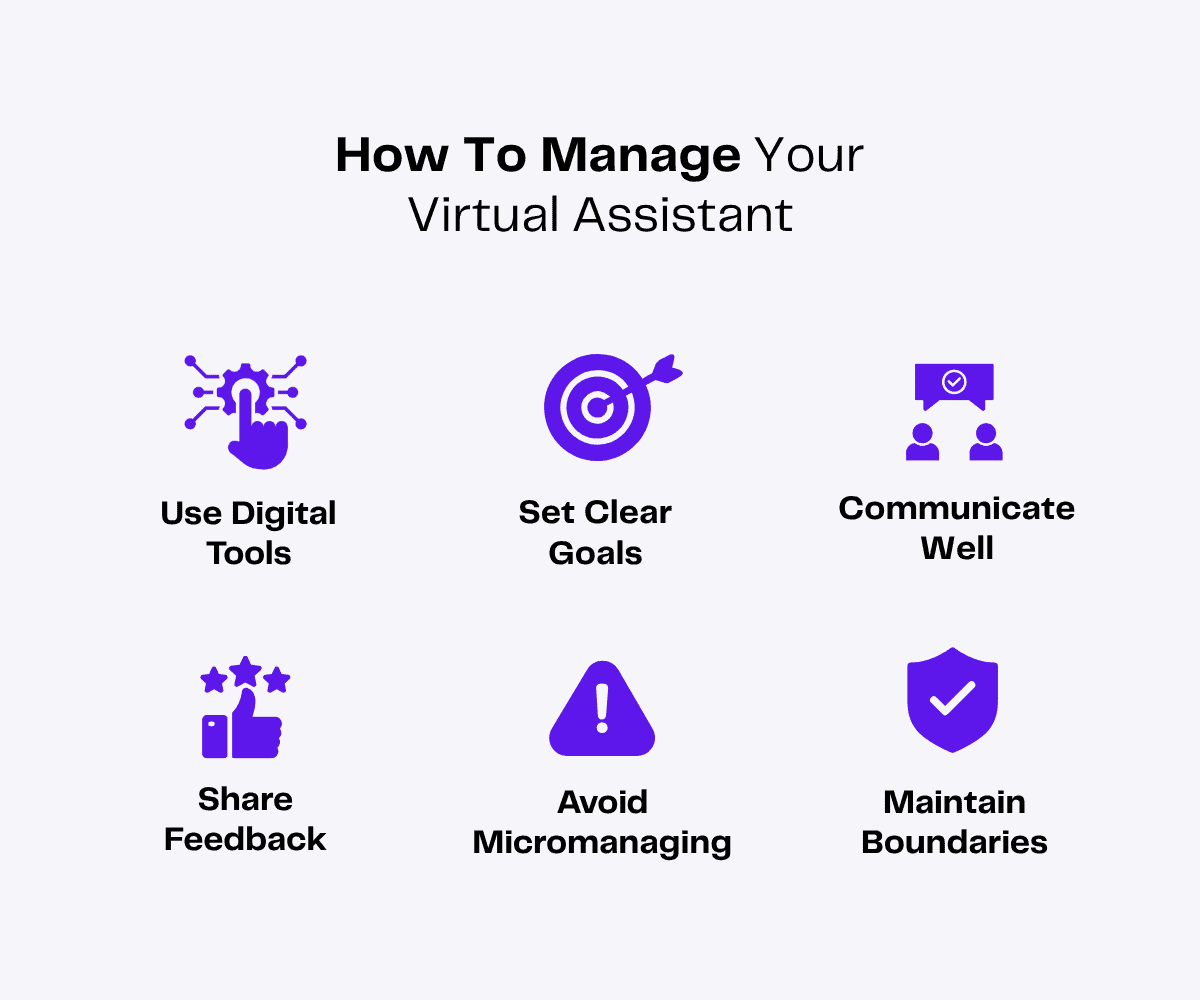
Use Top Digital Tools
To assign tasks, manage deadlines and track progress, you can subscribe to Asana, Trello, Zoho Projects or Jira.
Remember, many of these management software offer integrations with other tools such as Slack or Todoist. Make the best use of this feature to unify systems and enhance cooperation.
File-sharing services like Dropbox and Google Drive allow you to send, receive and store media in a centralized folder on the cloud.
With the right resources in place, the benefits of remote employees can be tripled!
Set Clear and Realistic Deadlines
Clearly explain what must be done and by when. In fact, let them know how not meeting this deadline might impact your business.
Share details about which tasks need to be completed on an urgent basis. Prioritization is important to keep projects aligned with your business’s higher goals.
Positive affirmation only pushes them in the right direction. So you can consider simple rewards or gestures to appreciate your VA when they’ve met a last-minute deadline.
Communicate Consistently
You can improve collaboration by communicating mindfully and consistently.
Synchronous communication, i.e., real-time collaboration, includes video conferencing and phone calls. You can hop on these online meetings for urgent team discussions and regular check-ins.
You can even host virtual coffee breaks and have some good-humored conversations for stronger team building.
Zoom, Microsoft Teams and Google Meet are ideal for video meetings. Audio calls can be made through Google Voice.
Asynchronous communication takes place when the message is not time-sensitive. Direct messages and emails don’t require immediate replies. This saves a lot of time as you don’t have to call a meeting for every little thing.
Slack, Google Chat and Gmail can be used for work chats.
Share Constructive Feedback
Feedback is non-negotiable! It fosters learning and is the path to continuous improvement.
So to develop your virtual assistant’s full potential, don’t shy away from letting them know if you need them to adopt a different approach, use a different software, work on project quality or be available at a particular time of day.
Give specific, actionable advice and maintain a positive attitude.
Don’t forget that a good feedback culture goes both ways. So be receptive to suggestions on your processes, projects and workflows as well.
Avoid Micromanagement
When managers try to help their team, they have the best interests at heart.
But excessive, interruptive control that leaves no room for creativity and decision-making is counterproductive for teams.
So avoid micromanaging your virtual assistant. Have faith in their abilities.
Let them know that you trust them. This way, your VA can move out of their comfort zone and take on more responsibility. Once enough time has passed, you can even get them to fill in for you.
When you’re not required to help with every little thing, you get to focus on the bigger picture.
Establish Work-Life Boundaries
After training and integrating them into your workflows, you can start delegating to your virtual assistant!
Get focused during work. Tell them what hours you’re available for project discussions. Busy working on a high-priority project? Let them know you won’t be available.
When you’re at home, be there completely. If you’re taking a day off to spend time with your family, going on vacation or getting health checkups, ask them not to disturb you.
When you know you have your VA’s support, you get to be present mindfully. So you work when you’re supposed to work and relax when you’re supposed to relax.
Read more: Best Practices for Delegating to Your Virtual Assistant
How Is Virtual Assistant Outsourcing Changing in 2025?
The business process outsourcing (BPO) market revenue is projected to cross $400 billion in 2025.
Rapid globalization is driving companies to outsource to regions with lower labor costs.
Plus, increasing competition has compelled businesses to optimize their core operations. By delegating non-essential tasks to virtual assistants, companies can focus more on income-generating activities.
Here are some other factors steering businesses to outsource.
Rise of Remote Work
60% of employers now prefer remote work. It enables businesses to hire candidates from anywhere in the world and significantly reduce overhead expenses.
Plus, it boosts employee productivity, reduces absenteeism and improves retention.
Ethical and environmental concerns have also pushed companies to go virtual.
Daily commutes to and from the office contribute significantly to carbon emissions. Moreover, traffic jams delay employees, costing the U.S. economy up to $78 billion a year in productivity.
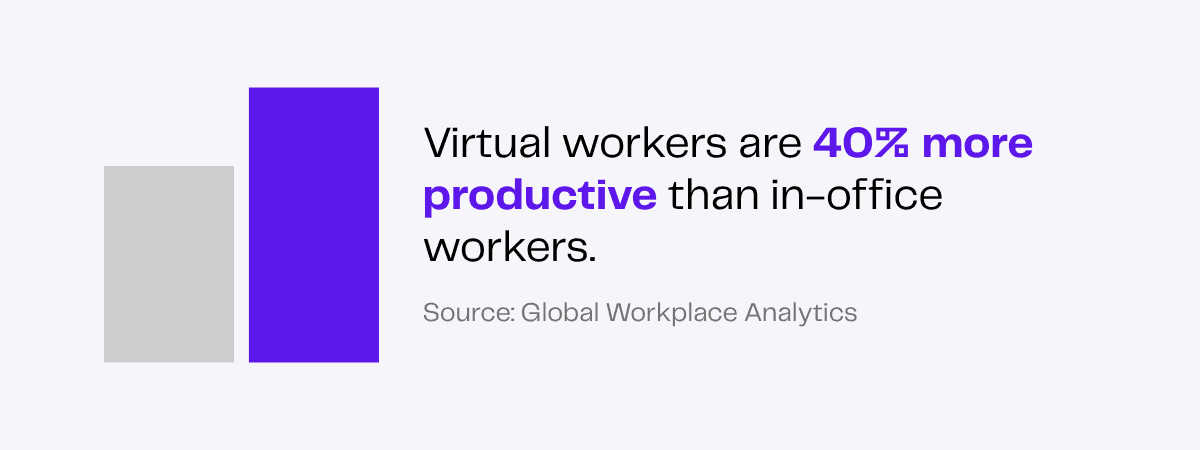
All this can be avoided with remote work.
- Virtual workers are reported to be 40% more productive than in-office ones.
- Unscheduled leaves can cost up to $300 billion a year in financial losses.
- 95% of companies say remote work has improved retention rates.
- 70% of employees view climate-conscious companies in a better light.
Evolving Customer Expectations
The growth of social media and instant messaging platforms has led to an expectation of 24/7 availability.
Customers no longer want to wait for answers. 78% of support agents say that customers are more impatient than they used to be.
Not only that, but consumers also want multi-channel support and personalized interactions.
Outsourcing can help businesses keep up with these rising expectations. By hiring candidates from different time zones, companies can ensure broader coverage, lower wait times and higher customer satisfaction.
Growth of AI
AI and machine learning (ML) technologies have taken the world by storm. From startups to enterprises, every business wants to leverage AI to streamline operations and enhance accuracy.
However, using these technologies still requires human expertise. As a result, the demand for services like data labeling, annotation, tagging and categorization is expected to grow.
Startups that lack in-house expertise can easily outsource data labeling to make the most of the latest technologies.
Final Thoughts
Virtual assistant outsourcing has high returns on investment. It’s a strategic move to support your day-to-day operations and raise the bottom line.
With Zenius, you can hire talented and professional virtual assistants.